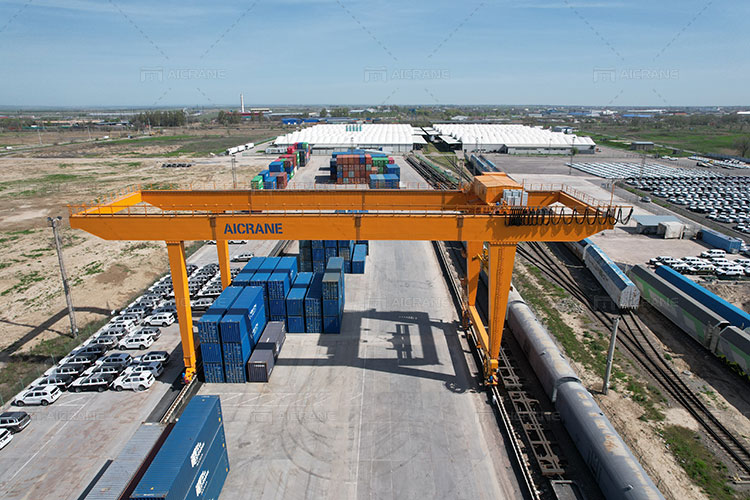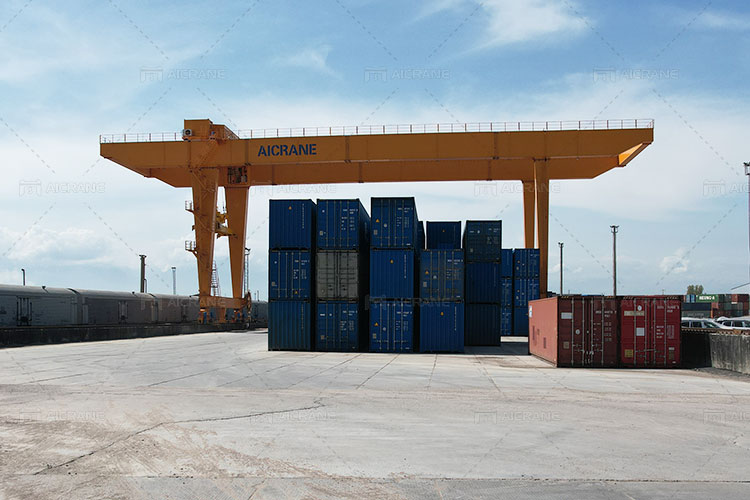Container gantry cranes are essential pieces of equipment in ports and logistics terminals, enabling the efficient handling of shipping containers. However, their cost can vary significantly based on a variety of factors. Understanding these factors can help businesses make informed purchasing decisions and plan their budgets effectively. This article explores the key elements that influence the price of container gantry cranes.

1. Type of Container Gantry Crane
The first major determinant of cost is the type of container gantry crane. There are primarily two types:
- Rubber-Tired Gantry Cranes (RTGs): These RTG rubber tyred gantry cranes are mobile and designed to operate on rubber tires, allowing them to move between different areas in a terminal. RTGs tend to be more expensive due to their mobility features and sophisticated steering systems.
- Rail-Mounted Gantry Cranes (RMGs): These cranes operate on fixed rails and are ideal for high-volume, repetitive operations in ports and intermodal yards. While generally more affordable than RTGs, their cost can increase with additional features such as automation.
2. Lifting Capacity
The lifting capacity of a container gantry crane directly affects its price. Cranes designed to handle heavier loads require stronger materials, larger motors, and more robust structural components. For example, a crane with a lifting capacity of 40 tons will cost more than one with a capacity of 20 tons.
3. Span and Lifting Height
The span, or the width of the crane, and its lifting height also play a significant role in determining cost. A wider span allows the crane to cover more container rows, which is critical in busy ports. Similarly, a higher lifting height is necessary for stacking containers vertically. Both of these features require additional engineering and materials, increasing the overall gantry crane cost.
4. Level of Automation
Automation is becoming increasingly common in container gantry cranes, enabling faster, more efficient, and safer operations. Automated or semi-automated cranes are equipped with advanced systems such as:
- Anti-sway technology
- GPS and RFID tracking
- Remote monitoring and operation systems
These technologies enhance functionality but significantly increase the crane’s upfront cost. However, they may reduce operational expenses over time by lowering labor costs and improving efficiency.

5. Customization Requirements
Standard container gantry cranes are more affordable compared to customized models. Businesses with unique operational needs, such as non-standard container sizes, extreme weather conditions, or specific site constraints, may require tailored designs. Customization often involves additional engineering, specialized components, and extended manufacturing timelines, all of which increase costs.
6. Materials and Build Quality
The quality of materials used in construction directly impacts the crane’s durability and price. High-grade steel, corrosion-resistant coatings, and premium components contribute to higher costs but ensure longer service life and better performance in harsh environments. Cheaper materials may reduce the initial price but can lead to higher maintenance costs and shorter lifespan.
7. Manufacturer and Brand Reputation
The choice of gantry crane manufacturer also influences the cost. Established brands with a strong reputation for quality, reliability, and after-sales service often charge a premium. While these cranes may have a higher upfront cost, they offer better long-term value due to superior performance, lower downtime, and comprehensive support services.
8. Geographic Location and Transportation Costs
The location of the buyer and the manufacturer impacts transportation costs. Importing a crane from overseas can add significant shipping and logistics expenses, including:
- Freight charges
- Customs duties and taxes
- Insurance
Choosing a local manufacturer can reduce these costs, but it’s essential to balance transportation savings against the quality and features of the crane.
9. Installation and Commissioning
The installation and commissioning process for container gantry cranes is complex and requires skilled technicians. Some manufacturers include these services in the crane’s price, while others charge separately. Factors like site conditions, the complexity of the crane, and the need for additional infrastructure can further increase installation costs.
10. Warranty and After-Sales Service
Cranes with comprehensive warranties and robust after-sales service packages typically cost more. However, these additional costs can be a worthwhile investment. Reliable after-sales support ensures that the crane remains operational, minimizing downtime and extending its lifespan.
11. Energy Efficiency Features
Modern container gantry cranes often come with energy-efficient technologies, such as regenerative braking systems and hybrid power solutions. While these features add to the initial cost, they reduce energy consumption and operational expenses, offering long-term savings.
12. Market Conditions and Supply Chain Factors
Global market conditions, such as raw material prices, labor costs, and currency exchange rates, can influence the price of container gantry cranes. Supply chain disruptions, like those experienced during the COVID-19 pandemic, can lead to delays and increased costs for both manufacturers and buyers.
Cost-Benefit Analysis: Balancing Price and Value
When evaluating the cost of a container gantry crane, it’s essential to consider both the upfront price and the long-term value. A higher initial investment in a well-built, technologically advanced crane can result in significant savings through reduced maintenance, energy efficiency, and increased productivity.
Conclusion
The price of a container gantry crane is influenced by multiple factors, including type, capacity, customization, materials, and market conditions. By understanding these elements, businesses can make informed decisions that align with their operational needs and budget. Investing in the right crane ensures efficient container handling, long-term reliability, and optimal return on investment.
